| |
| |
Photographer,
Location |
Images |
Comments |
|
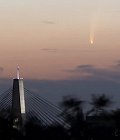
|
Grahame
Kelaher,
Sydney, NSW, Australia
Jan. 16, 2007 |
#1,
#2, more |
Comet
McNaught really put on a show for Sydney tonight, estimated
mag was -2.5 (+-0.5). It was easily visible on the horizon
for about 30 mins after sunset!
Photo
details: Canon
20D, ISO 200 with a 70-300mm lens, f/5.6, with 2x teleconvertor.
|
|
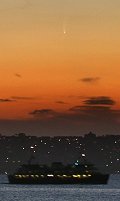
|
Geoff
Sims,
Manly, Sydney, Australia
Jan. 16, 2007 |
#1,
#2, #3,
#4 |
Comet
McNaught put on a great show last night and its tail was
clearly visible to the naked eye. It was a beautiful scene:
the Comet and Venus in the twilight sky, setting over beautiful
Sydney Harbour - note also the passing Ferries. Photos taken
with an Olympus C-5050. |
|
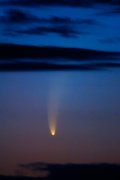
|
David
Summerhayes,
Sellicks Beach, near Adelaide, South Australia
Jan. 16, 2007 |
#1,
#2 |
The
long summer twilight made viewing a little difficult, but
the photos came out nicely!
Photo
details: #1-Nikon
D200, 500mm
lens; #2-Canon
5D, 400mm
lens |
|
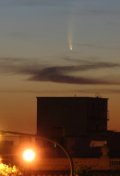
|
Mariano
Ribas,
Buenos Aires, Argentina
Jan. 16, 2007 |
#1,
#2 |
Here in Argentina, the Great Comet McNaught is a real hit.
It's a wonderful sight after sunset. The comet is around
magnitude -3, and its bright and curved tail is easy to
see with the naked eye. |
|
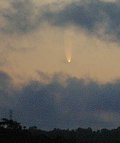
|
Mark
Keech,
Otford, NSW, Australia
Jan. 16, 2007 |
#1 |
It
looked as though we would miss out on a view of Comet McNaught
due to increasing cloud cover on the western horizon, but
we ended up with a more spectacular show than that of Monday
night because the comet was in a darker part of the sky.
Photo
details: Camera: Pentax
*istDL, 100-300
mm Sigma lens, ISO 1600, 1/4s, f6.7 |
|
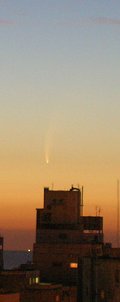
|
Daniel
Augusto Chiesa ( DanAug),
Montevideo, Uruguay
Jan. 16, 2007 |
#1,
#2, #3,
#4, more |
Photo details:
Nikon
Coolpix digital E-5600 |
|
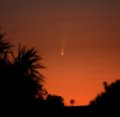
|
John
Burt,
Gisborne, New Zealand
Jan. 16, 2007 |
#1 |
Comet
McNaught put on its first really stunning evening show for
us in the southern hemisphere.
Photo
details: Modified Canon
300D, 300mm
zoom lens at f5.6, 1/50s, iso 400. |
|
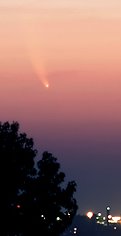
|
Rogerio
Marcon,
Campinas - Sao Paulo - Brasil
Jan. 16, 2007 |
#1,
#2 |
Photo details:
Canon 20D, 1/4
sec, ISO 200, Pentax
105mm lens |
|
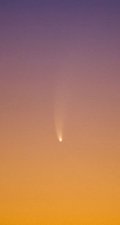
|
George
de San Miguel,
Fremantle, Western Australia
Jan. 16, 2007 |
#1 |
Two
days after first being glimpsed from Fremantle, McNaught
put on a spectacular naked eye display. |
|
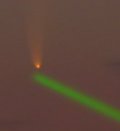
|
Marco
Nero,
Castle Hill, Sydney, Australia.
Jan. 16, 2007 |
#1,
#2, #3 |
These
pictures were taken on the second night of visibility (Jan
16 EST) which was much more impressive than the night before.
I used a >250mW
green laser to target and mark the location of the comet
as it was moving swiftly (as it approached the horizon).
Photo
details: Wicked Lasers >250mW 532nm 'SPYDER
II' Laser. Camera: Canon
Powershot Pro 1 with added 300mm (equiv) Tele lens |
more
images: from
Katie Everett on an escarpment of the Darling Range, Clifton
Hills, Perth, Western Australia; from
Steven Graham of Christchurch, New Zealand; from
Marcio Almeida Ribeiro of Sao Paulo, SP, Brazil; from
Dicky Tong of Top Ryde, Sydney, Australia; from
Claudio Basualto Merino of Puerto Montt, Chile; from
Julio C G Sampaio of Perth - WA - Australia; from
Adam Branford of Mount Gambier, South Australia; from
Cassiano Macedo of Sao Paulo, Brazil; from
Frank Tornyai of Auckland, North Shore, New Zealand; from
Yuri Deans of Perth, Western Australia; from
Chris Norman of Monument Hill, Fremantle, Western Australia;
from Adrian Moore of
Kurri Kurri N.S.W Australia;
|
|